Abstract
In males of mealy bugs with the lecanoid chromosome system, the paternal set of chromosomes becomes heterochromatic in early embryogeny. In males of the mealy bug, Planococcus citri, the heterochromatic (H) set in testis sheath cells and in most of the oenocytes apparently did not replicate while the euchromatic (E) set was undergoing several cycles of endoreplication. In third instar males, testis sheath cells in endoanaphase and endotelophase exhibited 5H and either 40 or 80E chromosomes. The increase in the number of E chromosomes was attributed to the replication of only the E chromosomes. Oenocytes of third instar males had 0, 5, or 10H chromosomes and from 10 to 240E chromosomes. The oenocytes with 5H chromosomes had a mean of 50.8E chromosomes, and those with 10H chromosomes had a mean of 155.6E chromosomes. Nuclear and cell fusion was considered as a means of producing the various numbers of H and E chromosomes in oenocytes, and it was concluded that although nuclear fusion probably took place, the differences between the number of H and E chromosomes was at least in part due to replication of only the E chromosomes. The size of the H chromosomes was about the same in all the testis sheath cells and the oenocytes irrespective of the level of endopolyploidy for the E set. These H chromosomes apparently did not increase in polyteny, because they were only about half the size of the H chromosomes in prophase I of spermatogenesis. The significance of the nonreplication of the H set and the control of nonreplication are briefly discussed.
Similar content being viewed by others
References
Baer, Dee: Asynchronous replication of DNA in a heterochromatic set of chromosomes in Pseudococcus obscurus. Genetics 52, 275–285 (1965).
Brown, S. W.: The Comstockiella system of chromosome behavior in the armored scale insects (Coccoidea: Diaspididae). Chromosoma (Berl.) 14, 360–406 (1963).
—, and W. A. Nelson-Rees: Radiation analysis of a lecanoid genetic system. Genetics 46, 983–1007 (1961).
Geitler, L.: Endomitose und endomitotische Polyploidisierung. Protoplasmatologia 6/C, 1–89 (1953).
Hughes-Schrader, Sally: Cytology of coccids (Coccoidea-Homoptera). Advanc. Genet. 2, 127–203 (1948).
Loewus, Mary W., S. W. Brown, and A. D. McLaren: Base ratios in DNA in male and female Pseudococcus citri. Nature (Lond.) 203, 104 (1964).
Nur, U.: A modified Comstockiella chromosome system in the olive scale insect, Parlatoria oleae (Coccoidea: Diaspididae). Chromosoma (Berl.) 17, 104–120(1965); - Euchromatization, and the activity of the heterochromatic chromosome set in the male mealy bug. M.S. 1966.
Rudkin, G. T.: The structure and function of heterochromatin. Proc. 11th Intern. Congr. Genet. 2, 359–374 (1963); - Nonreplicating DNA in giant chromosomes. Genetics 52, 470 (1965).
Snow, R.: Hydrochloric acid-carmine as a stain for chromosomes in squash preparations. Stain Technol. 38, 9–13 (1963).
Author information
Authors and Affiliations
Additional information
This study was aided by a grant (GB-1585) from the National Science Foundation, Washington, D.C.
Rights and permissions
About this article
Cite this article
Nur, U. Nonreplication of heterochromatic chromosomes in a mealy bug, Planococcus citri (Coccoidea: Homoptera). Chromosoma 19, 439–448 (1966). https://doi.org/10.1007/BF00333048
Received:
Issue Date:
DOI: https://doi.org/10.1007/BF00333048




